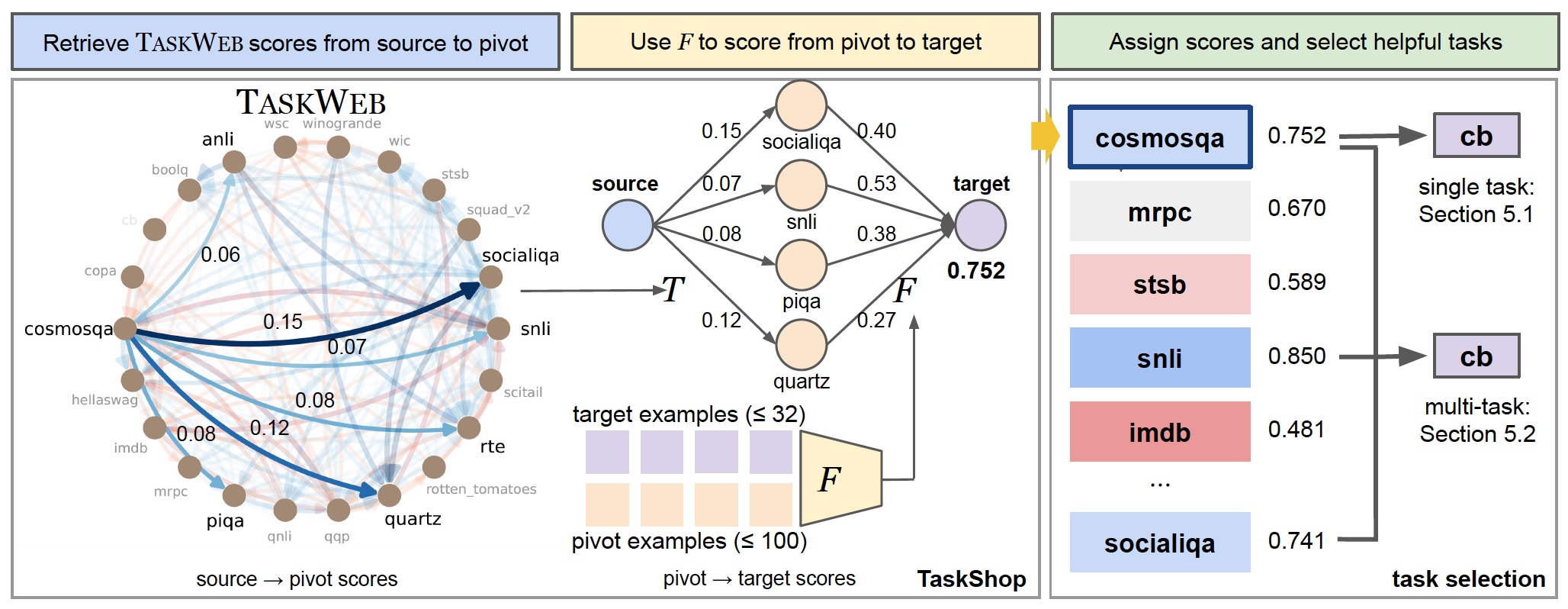This is the original implementation of TaskWeb: Selecting Better Source Tasks for Multi-task NLP by Joongwon Kim, Akari Asai, Gabriel Ilharco and Hannaneh Hajishirzi.
Our project page is available here!
Perform the following installation to run all code associated with this repository. We use Python 3.8.13 for our code. Create a new conda environment with the specific Python version and install the libraries specified in the
conda create -n <ENV_NAME> python=3.8.13
conda activate <ENV_NAME>
pip install -r requirements.txt
TaskWeb, our repository of pairwise task transfer across 22 different tasks in seven different adaptation settings, is available in the data/taskweb subdirectory. The taskweb.p file contains the processed TaskWeb results and the data/taskweb/results subdirectory contains the original performances of models transfered via source⭢target. Note that each subdirectory is formatted as <TARGET_TASK>/<SOURCE_TASK>/<MODEL_ID>-e<EPOCHS>-lr<LEARNING_RATE>-b<BATCH_SIZE>-s<SEED>.
We provide implementations of TaskShop as well as our baselines: LLM-similarity (Paranjape et al., 2023) and Retrieval-of-Experts (RoE, Jang et al., 2023). Note that our pre-computed scores have been provided, so continue to Single-Task Selection if needed.
Run the following code to obtain task transferability predictions for TaskShop for all tasks used in our experiments. Use roe to use Retrieval-of-Experts and llm to use LLM-similarity as the backbone task selection module. Omit the target_num argument when using llm.
cd taskshop
python taskshop_predict.py --task_selection roe --model_id all-MiniLM-L6-v2 --target_num 32
Similarly, run the following code to obtain task transferability predictions for LLM-similarity and Retrieval-of-Experts, respectively.
python llm_predict.py --model_id text-davinci003 --openai_api_key <OPENAI_API_KEY>
python roe_predict.py --model_id all-MiniLM-L6-v2 --source_num 100 --target_num 32
Note that we use text-davinci-003 as our model for the LLM-similarity method, and all-MiniLM-L6-v2 for the Retrieval-of-Experts method. For Retrieval-of-Experts we use 100 examples of the source task and 32 examples of the target task.
Having obtained score predictions between pairs of tasks using the task selection methods above (LLM-similarity, Retrieval-of-Experts, TaskShop), we now apply them to two settings: selecting 1) a single helpful task for each target and 2) multiple helpful tasks for multi-task learning.
Run the following codes to evaluate the NDCG (normalized discounted cumulative gain) and Regret @ 5 for selecting single helpful tasks as reported in our paper.
LLM-Similarity
python llm_evaluate.py --model_id text-davinci-003
Retrieval-of-Experts
python roe_evaluate.py --model_id all-MiniLM-L6-v2 --target_num 32
TaskShop
python taskshop_evaluate.py --task_selection roe --model_id all-MiniLM-L6-v2 --target_num 32
Again, use roe to use Retrieval-of-Experts and llm to use LLM-similarity as the backbone task selection module. Omit the target_num argument when using llm.
Before proceeding, note that we provide the training and evaluation results for our multi-task training experiments - skip the following two scripts (train.sh and eval.sh) if needed. Meanwhile, our multi-task trained models are located here (check the keys and download the models of interest by appending the keys to the address). The complete list of our multi-task training set descriptions are provided in multitask/multitask_info.py.
To perform multi-task finetuning with our training sets, use the following command which assumes that slurm is installed as well as GPUs of
sbatch train.sh
Make sure to modify the contents inside the file such as the output directory, cache directory, etc.
Perform evaluation with the following script.
sbatch eval.sh
Again, check that the output and cache directories are set correctly.
Finally, run the following the code to obtain the post-processed experiment results in Table 3 of the paper.
python run_eval.py
Run the following code to obtain results reported in Table 4 of the paper (changing the number of tasks in the multi-task training set).
python run_eval_size.py
Run the following code to obtain results reported in Figure 4 of the paper (changing the mixture of helpful and unhelpful source tasks for each target).
python run_eval_mix.py
